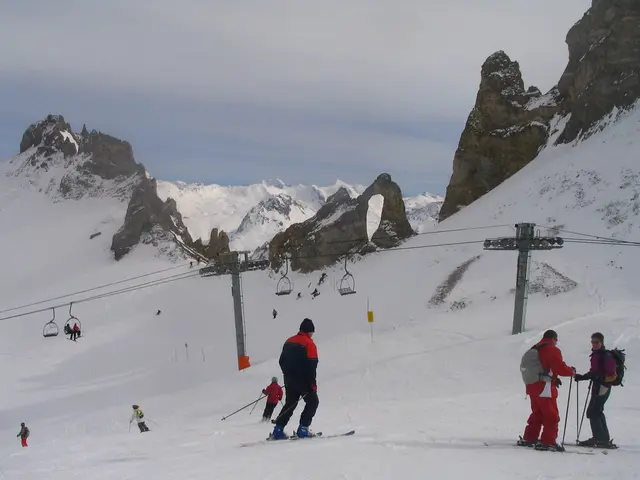Kenya's Assessment of Hydrology Progress: Building a Hydrospatial Data System
Kenya is making significant strides in the development of hydrospatial data, a critical component of its Blue Economy agenda. This advancement is evident in the country's focus on seabed mapping and ocean data initiatives.
The Kenya National Hydrographic Office (KNHO), mandated to coordinate hydrographic services across various government Ministries, Departments, and Agencies (MDAs) in Kenya, is at the forefront of these efforts. The KNHO, established in 1991 under the Survey of Kenya (SoK) and becoming operational in 2006, is now equipped with complex algorithms to process data and information, paving the way for hydrographic surveys towards hydrospatial.
Kenya's Blue Economy ambitions are closely tied to the understanding and management of its marine environments. With a coastline of approximately 536 km along the Indian Ocean and an Exclusive Economic Zone (EEZ) covering about 142,000 km, the potential for sustainable resource exploitation is immense. In fact, a continental shelf survey in 2007 determined that Kenya's EEZ has a potential extension of its continental shelf beyond the 200nm by approximately 103,302 km.
Seabed mapping plays a crucial role in enabling Kenya to utilize its marine resources effectively and safely, contributing to coastal and maritime development goals aligned with the Blue Economy framework. These activities align with global initiatives like Seabed 2030, which aims to comprehensively map the world's ocean floors, enhancing data availability and collaboration on ocean spatial data, of which Kenya is a part or benefits indirectly.
The opportunities in the discipline of hydrography are immense, considering the current inadequacy of expertise in the field. The development of hydrographic technology has shifted focus from what the ocean floor looks like to what is in the water, leading to an increase in the use of marine and aquatic data and information.
The United Kingdom Hydrographic Office (UKHO) is the Primary Charting Authority for Kenya, responsible for the publication, maintenance, and distribution of nautical charts and publications on behalf of Kenya. The KNHO currently has one Category (CAT) A hydrographer, seven CAT B hydrographers, and one CAT B nautical cartographer.
Future plans include the development of seven small ports along the Indian Ocean, with modernization, expansion, and benchmarking against international best practices and standards. The Kenya Marine Fisheries and Research Institute (KMFRI) produces tide tables, but only the Admiralty Tide Tables are recognized as the official product for use in Kenyan waters by the Kenya Maritime Authority (KMA).
The skills required in the hydrographic and hydrospatial sphere will change, creating demand for new training and providing new career opportunities. The data and information collected once will respect the FAIR principles to be used many times, and the quantity and variety are set to increase significantly with more multi-spectrum data being collected across a broader range of environments from a broader range of sensors employing more autonomous collection methods.
KNHO is currently working on developing a foundational bathymetric data layer for hydrospatial data infrastructure, including physical, biological, and chemical data and information in the water domain. The Fundamentals of Ocean Mapping are a key course in the International Oceanographic Commission's Ocean Teacher Global Academy (OTGA) program, emphasising the importance of hydrographic data as a foundation layer for all maritime data.
The key components of the Blue Economy include recycling, tourism, small-scale fishing, maritime transport and security, oil and mineral exploitation, spatial land-sea planning, environmental conservation, and climate change geared towards a sustainable Blue Economy under Sustainable Development Goal 14 (SDG14). The opportunities presented in the discipline of hydrography are immense, considering the current inadequacy of expertise in the field and the need to explore and exploit the oceans and aquatic resources under hydrospatial for the Blue Economy banner.
- Kenya's advancement in hydrospatial data is a critical part of its Blue Economy agenda, focusing on seabed mapping and ocean data initiatives.
- The Kenya National Hydrographic Office (KNHO) leads hydrographic services across various government Ministries, Departments, and Agencies (MDAs) in Kenya.
- Established in 1991 under the Survey of Kenya (SoK) and operational since 2006, the KNHO utilizes complex algorithms for data processing, facilitating hydrographic surveys.
- Kenya's Blue Economy ambitions are linked to the management of its marine environments, with a coastline of approximately 536 km along the Indian Ocean and an Exclusive Economic Zone (EEZ) covering about 142,000 km.
- A continental shelf survey in 2007 determined that Kenya's EEZ has a potential extension of its continental shelf beyond the 200nm by approximately 103,302 km.
- Seabed mapping is essential for Kenya to utilize its marine resources effectively and safely, contributing to coastal and maritime development goals aligned with the Blue Economy framework.
- Global initiatives like Seabed 2030 aim to enhance data availability and collaboration on ocean spatial data, with Kenya being a part or indirect beneficiary.
- The opportunities in hydrography are immense due to the current inadequacy of expertise in the field.
- The development of hydrographic technology has shifted focus from the ocean floor to what's in the water, increasing the use of marine and aquatic data and information.
- The United Kingdom Hydrographic Office (UKHO) is the Primary Charting Authority for Kenya, responsible for nautical charts and publications.
- The KNHO's workforce includes one Category (CAT) A hydrographer, seven CAT B hydrographers, and one CAT B nautical cartographer.
- Future plans involve developing seven small ports along the Indian Ocean, with modernization, expansion, and adherence to international best practices and standards.
- The Kenya Marine Fisheries and Research Institute (KMFRI) produces tide tables, but only the Admiralty Tide Tables are recognized as the official product for use in Kenyan waters by the Kenya Maritime Authority (KMA).
- The skills required in the hydrographic and hydrospatial sphere will evolve, creating demand for new training and career opportunities.
- The data and information collected once will adhere to the FAIR principles to be used many times, with a significant increase in quantity and variety as more multi-spectrum data is collected.
- KNHO is working on developing a foundational bathymetric data layer for hydrospatial data infrastructure, including physical, biological, and chemical data in the water domain.
- The Fundamentals of Ocean Mapping are a key course in the International Oceanographic Commission's Ocean Teacher Global Academy (OTGA) program, emphasizing the importance of hydrographic data as a foundation layer for all maritime data.
- The key components of the Blue Economy include recycling, tourism, small-scale fishing, maritime transport and security, oil and mineral exploitation, spatial land-sea planning, environmental conservation, climate change, and sustainable Blue Economy under Sustainable Development Goal 14 (SDG14).
- The opportunities presented in hydrography are immense due to the current inadequacy of expertise in the field and the need to explore and exploit the oceans and aquatic resources under hydrospatial for the Blue Economy banner.
- Hydrography and hydrospatial science intersect with other disciplines like marine science, science, climate-change, environmental-science, space-and-astronomy, cybersecurity, lifestyle, home-and-garden, data-and-cloud-computing, sustainable-living, technology, education-and-self-development, personal-growth, career-development, job-search, learning, skills-training, sports, football, champions-league, baseball, hockey, golf, sports-betting, European leagues, basketball, NBA, NCAA basketball, MLB, NHL, racing, premier-league, tennis, sports-analysis, weather-forecasting, auto-racing, mixed-martial-arts, weather, Laliga, and horse-racing.
- Climate change affects weather patterns and may impact the Blue Economy, making weather forecasting essential for safe navigation and resource management.
- The future of hydrography and hydrospatial science promises exciting advancements in technology, data collection, and analysis, contributing to a better understanding of our oceans and aquatic resources.






